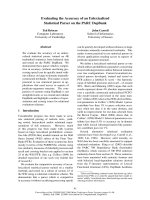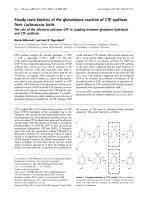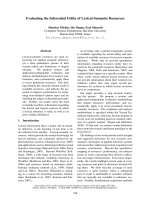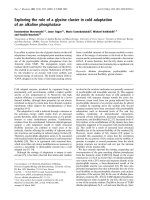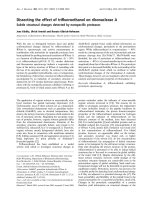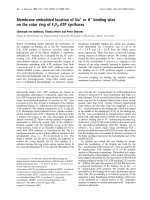Báo cáo y học: "Evaluating the Safety of Intranasal Steroids in the Treatment of Allergic Rhinitis" docx
Bạn đang xem bản rút gọn của tài liệu. Xem và tải ngay bản đầy đủ của tài liệu tại đây (114.25 KB, 5 trang )
ORIGINAL ARTICLE
Evaluating the Safety of Intranasal Steroids in the
Treatment of Allergic Rhinitis
Ketan Sheth, MD, MBA
Given that intranasal corticosteroids (INCs) are widely considered first-line therapies for treatment of rhinitis, it is important for the
clinician to be comfortable with the side-effect profile and be able to discuss potential safety concerns regarding these therapies.
Among the safety concerns with the use of INCs are the potential for growth suppression both short and long term, the potential for
hypothalamic-pituitary-adrenal axis suppression, ocular safety, and the use of INCs concomitantly with inhaled corticosteroids in
asthma patients. As all clinicians are aware, each patient can have individual responses to both efficacy and safety; however, the data
reviewed suggest that the benefits outweigh the potential risks. Understanding the potential concerns and the data behind these
concerns should give clinicians the information to be able to discuss this with patients and parents to incorporate appropriate
therapy for those with allergic rhinitis.
Key words: allergic rhinitis, intranasal corticosteroids, safety, treatment
A
llergic rhinitis (AR) affects almost 94 million
Europeans, 50 million Americans, and 10 million
Canadians.
1
Because it is so prevalent, almost all primary
care physicians will encounter this disease. Health Canada
estimates that nonfood allergies are ‘‘the most common
chronic condition in Canadians 12 years of age and
older.’’
1
In one study, 42% of children were diagnosed
with AR by the age of 6 years. The prevalence of AR has
increased dramatically in the past 30 years and continues
to increase. Children with one component of atopy (AR,
asthma, eczema) have a threefold greater risk of developing
a second component.
2
In 1998, the Joint Task Force on Practice Parameters in
Allergy, Asthma, and Immunology defined rhinitis as
‘‘inflammation of the membrane lining the nose, character-
ized by nasal congestion, rhinorrhea, sneezing, itching of the
nose and/or post-nasal drainage.’’
3
AR is the nasal symptoms
that result from a hypersensitivity reaction to specific
allergens occurring in sensitized patients, which is mediated
by IgE antibodies, in which the end result is inflammation.
Management of AR is important for preventing the
symptoms but also for preventing potential complications
of the disease. The options for treatment include allergen
avoidance, pharmacotherapy, and immunotherapy.
4
Pharmacotherapy options for AR include antihista-
mines (oral and intranasal), oral leukotriene receptor
antagonists, and INCs. Treatment guidelines for AR
support the use of INCs as first-line therapy. The Joint
Task Force on Practice Parameters in Allergy, Asthma, and
Immunology concluded that ‘‘extensive clinical and
toxicological studies have generally demonstrated that
nasal corticosteroids have an excellent benefit/risk profile
in long term usage in children’’
3
INCs are approved for use
as low as age 2 years in pediatric patients. Given that INCs
are widely considered first-line therapies for treatment of
rhinitis, it is important for the clinician to be comfortable
with the-side effect profile and be able to discuss potential
safety concerns regarding these therapies. Among the
safety concerns with the use of INCs are the potential for
growth suppression both short and long term, the
potential for hypothalamic-pituitary-adrenal (HPA) axis
suppression, ocular safety, and the use of INCs concomi-
tantly with inhaled corticosteroids in asthma patients.
Growth
An early study that examined the effect of the use of
beclomethasone dipropionate (BDP) in AR raised con-
cerns about the potential for growth suppression with INC
Ketan Sheth: Lafayette Allergy and Asthma Clinic, Lafayette, IN, USA;
Department of Pediatrics, Indiana University School of Medicine,
Indianapolis, IN, USA; Department of Pharmacy, Purdue University,
West Lafayette, IN, USA.
Correspondence to: Ketan Sheth, MD, MBA, Lafayette Allergy and
Asthma Clinic, 1345 Unity Place, Suite 145A, Lafayette, IN 47905 USA;
e-mail:
DOI 10.2310/7480.2008.00014
Allergy, Asthma, and Clinical Immunology, Vol 4, No 3 (Fall), 2008: pp 125–129 125
use.
5
In this study, 100 children aged 6 to 9 years of age
were studied for 1 year to measure the effect of INCs on
growth. One group (51 children) received BDP 168 mg
twice daily and the other (49 children) a placebo nasal
spray in a double-blind fashion. The children were
prepubertal and had normal growth prior to the study.
During the study, the children had their heights measured
by stadiometry at months 1, 2, 4, 6, 10, and 12 of
treatment. They also had their HPA axis assessed via 8
AM
cortisol and cosyntropin stimulation testing. The results
showed that the mean change in height was 5.0 cm/yr in
the BDP group compared with 5.9 cm/yr in the placebo
group (p , .01). The mean overall rate of growth was
0.14 mm/d for BDP versus 0.16 mm/d for placebo
(p , .01). There were no differences in the 8
AM cortisol
or response to cosyntropin stimulation. This study was one
of the first to show a negative effect on growth in pediatric
patients with INC use. In addition, the HPA axis was not
affected in these patients. To date, this is the only study
that shows an effect on growth with INC therapy.
Subsequent studies with other INCs have not shown a
similar effect on growth, suggesting that the effect with
BDP was specific to that molecule, perhaps owing to its
metabolite, beclomethasone monopropionate, with high
systemic bioavailability or to the twice-daily dosing
regimen. Murphy and colleagues examined the effect of
once-daily therapy with budesonide (BUD) aqueous nasal
spray on growth velocity in children with perennial AR.
6
They studied 229 children ages 4 to 8 years. The mean
growth velocity was 5.91 cm/yr in the BUD-treated
children versus 6.19 cm/yr in the placebo-treated patients
(p 5 not significant).
Two newer-generation corticosteroids that have high
first-pass metabolism and low systemic bioavailability have
also been studied. Schenkel and colleagues examined the
effect of intranasal mometasone furoate (MF) on growth.
7
They studied 49 children treated with MF and 49 with
placebo over 1 year. The children treated with MF had a
mean change of 6.95 cm/yr versus 6.35 cm/yr in the placebo.
Allen and colleagues did a similarly designed double-blind,
parallel-group, multicentre study in children with perennial
AR using the corticosteroid fluticasone propionate (FP).
8
In
this study, 74 children were treated with FP and 76 with
placebo for 1 year. The children treated with FP had a
mean change of 6.4 cm/yr versus 6.4 cm/yr in the placebo.
Taken together, these studies are reassuring regarding a lack
of any effect on growth with the newer-generation, low-
bioavailability INCs in pediatric patients.
Knemometry is an alternative way to measure growth
in studies. It is more useful as a method to measure short-
term growth and has been reported as being a more
sensitive indicator of systemic bioactivity compared with
urinary cortisol measurement. Appropriately used, it can
measure changes as small as 0.1 mm over 1 week in lower
leg length; however, the use of knemometry on final adult
height or long-term (ie, greater than 6 months) growth has
not been conclusively established. In addition, few studies
have examined the correlation between short-term changes
in knemometry and long-term changes in growth.
Nonetheless, knemometry provides additional useful
information regarding effects on growth. Skoner and
colleagues examined growth as measured by knemometry
in 49 pediatric patients treated with either placebo,
triamcinolone acetonide (TAA) at doses of 110 mg and
220 mg, and FP 200 mg for 2 weeks in a four-way crossover
study.
9
The study predetermined that a 50% reduction in
lower leg growth velocity was clinically significant.
The magnitude of treatment effect was 219.6% for TAA
110 mg, 221.7% for FP, and 232.6% for TAA 220 mg. The
authors concluded that there was no statistically significant
difference in lower leg growth between any of the
treatments and placebo. Owing to the short nature of the
study and the large variability inherent in knemometry,
these large treatment effects did not reach the predeter-
mined values of 50% that the authors considered clinically
significant.
Newer-generation INCs have also been examined using
knemometry. Gradman and colleagues studied fluticasone
furoate (FF) over 2 weeks of treatment compared with
placebo in 53 children and found the change in lower leg
growth to be 0.42 mm/wk in the placebo group versus
0.40 mm/wk in the FF group.
10
There was no statistical
difference. Agertoft and Pedersen studied oral inhaled
ciclesonide (CIC) at doses of 40, 80, and 160 mgina
similar design in 24 children.
11
Note that this was an
asthma medication inhaled into the lung; however, the
data still provide useful information about medication
safety. In this study, there was a trend toward an effect
but no statistical significance. The placebo group grew
0.412 mm/wk, CIC 40 mg grew 0.425 mm/wk, CIC 80 mg
grew 0.397 mm/wk, and CIC 160 mg grew 0.370 mm/wk.
These short-term growth studies also provide the clinician
with reassurance regarding a lack of effect on growth with
newer-generation corticosteroids.
HPA Axis
Suppression of the HPA axis is one of the methods used to
determine if steroids have potentially negative effects.
Reviewing the types of studies and methods used to
126 Allergy, Asthma, and Clinical Immunology, Volume 4, Number 3, 2008
measure the HPA axis is beyond the scope of this article;
however, they have been elegantly reviewed by Allen.
12
Galant and colleagues performed a randomized, double-
blind, placebo-controlled study to evaluate the effects of
FP 200 mg daily on HPA axis function measured by 12-
hour urinary free cortisol levels in children 2 to 3 years of
age after 6 weeks of treatment.
13
FP was equivalent to
placebo with respect to effects on HPA axis function
measured by 12-hour urinary free cortisol. Grossman and
colleagues studied FP in 250 children aged 4 to 11 years
with seasonal AR.
14
They found that the morning plasma
cortisol concentrations and frequency of drug-related
adverse events were similar in the FP and placebo groups.
Furthermore, Wilson and colleagues studied 20
patients in a single-blind, randomized, four-way crossover
design and compared the systemic bioactivity of aqueous
formulations of BUD, MF, and TAA in terms of adrenal
gland, bone, and white blood cell markers.
15
The
individual treatments were separated by 7-day washout
periods. After 5 days of treatment at steady state, serial
blood and urine samples were taken for 24 hours.
Collective and fractionated measurements (daytime, over-
night, and 8
AM) were done on plasma cortisol and urine
cortisol/creatinine excretion. Plasma osteocalcin and blood
eosinophil counts were measured at 8
AM. The authors
found that there was no significant difference between
placebo and the active treatments with any of the markers
of adrenal suppression.
The newer INCs have also been studied with regard to
HPA axis suppression and safety. In a 6-week study in
children 2 to 5 years of age with perennial AR, daily doses
of 200, 100, and 25 mg of CIC nasal spray were compared
with placebo nasal spray.
16
The CIC-treated groups had a
numerically (but not statistically) greater decline in 24-
hour urinary free cortisol and plasma cortisol compared
with the placebo treated group. In a 12-week study in
children 6 to 11 years of age with perennial AR, daily doses
of 200, 100, and 25 mg of CIC nasal spray were compared
with placebo nasal spray. The CIC-treated groups had a
numerically (but not statistically) greater decline in 24-
hour urinary free cortisol compared with the placebo-
treated group. The mean morning plasma cortisol value
did not show any consistent treatment effect with
differences from placebo.
Another newer-generation INCs, FF has also been
evaluated with respect to HPA axis function. Allen and
colleagues measured serum cortisol after a single dose of
nasal FF and compared this with placebo.
17
They reported
a ratio of FF to placebo in serum cortisol. The ratios (95%
confidence interval) for FF 50, 100, 200, 400, and 800
micrograms were 1.00 (0.89–1.13), 1.04 (0.94–1.16), 1.05
(0.96–1.14), 1.06 (0.95–1.19), and 0.92 (0.82–1.04),
respectively. Tripathy and colleagues measured serum
cortisol levels after 6 weeks of therapy with FF in children
aged 2 to 12 years with perennial AR.
18
The ratio of end of
treatment to baseline was 0.98 in the placebo group and
0.94 in the FF-treated group. Patel and colleagues reported
a similarly designed study in adults (age 12 years and
above), which included an additional arm of prednisone
10 mg daily for the last 7 days of treatment.
19
The ratio of
end of treatment to baseline was 0.99 for placebo, 0.97 for
FF, and 0.49 for prednisone 10 mg groups. These data
suggest a minimal HPA axis effect with FF. The prescribing
information for FF provides additional data on urinary
cortisol levels from these studies. With the urinary cortisol
data, there was a large degree of variability in the measured
results.
20
Likely owing to this variability in urinary cortisol
values, a more conservative conclusion was reached by the
US Food and Drug Administration (FDA). According to
the FDA, ‘‘when the results of the HPA axis assessments
described above are taken as a whole, an effect of intranasal
FF on adrenal function cannot be ruled out, especially in
pediatric patients.’’
20
Ocular Safety
Another potential safety concern is ocular side effects.
Derby and Maier conducted a retrospective observational
cohort study of cataract incidence among users of oral and
INCs identified from the United Kingdom–based General
Practice Research Database with a nested case-control
analysis to control for confounding factors.
21
The study
population included 286,078 subjects aged less than 70
years old drawn from 350 general practices in England and
Wales. Patients were classified as users of only INCs, users
of only oral corticosteroids, and nonusers of either
medication. They found that the incidence rate of cataract
(1.0 per 1,000 person-years) among users of INCs was
similar to the incidence rate among nonusers. However,
oral corticosteroid users were at higher risk of cataract (2.2
per 1,000 person-years). In this study, approximately 70%
of INC exposure was to BDP only; the event rate in this
group was similar to that in the unexposed group. Cataract
risk did not increase with the number of prior prescrip-
tions for INCs. The authors concluded that the use of INCs
was not associated with an increased risk of cataracts in
this study population.
Another ocular concern is development of glaucoma or
increased intraocular pressure. Medication class warnings
suggest that nasal and inhaled corticosteroids may result in
Sheth, Safety of Intranasal Steroids in Treatment of Allergic Rhinitis 127
the development of glaucoma and/or cataracts. Therefore,
close monitoring is warranted in patients with a change in
vision or with a history of increased intraocular pressure,
glaucoma, and/or cataracts.
Specific data with CIC suggest minimal ocular effects.
The risk of glaucoma was evaluated by assessments of
intraocular pressure in three studies, including 943
patients. Of these, 390 adolescents or adults were treated
for up to 52 weeks and 186 children ages 2 to 11 years
received treatment for up to 12 weeks. In these trials, no
significant differences in intraocular pressure changes were
observed. Additionally, no significant ophthalmologic
differences between CIC nasal spray 200 mg and placebo-
treated patients were noted during the 52-week study of
adults and adolescent patients in whom thorough
ophthalmologic assessments were performed, including
evaluation of cataract formation using slit lamp examina-
tions.
16
Glaucoma and cataract formation with FF was
evaluated using intraocular pressure measurements and
slit lamp examinations in one controlled 12-month study
in 806 adolescent and adult patients aged 12 years and
older and in one controlled 12-week study in 558 children
aged 2 to 11 years.
20
Intraocular pressure remained within
the normal range (, 21 mm Hg) in $ 98% of the patients
in any treatment group in both studies. However, in the
12-month study in adolescents and adults, 12 patients, all
treated with FF, had isolated intraocular pressure mea-
surements that increased above normal levels ($ 21 mm
Hg). In the same study, which had a 3:1 (FF to placebo)
randomization schedule, seven patients (six treated with
FF and one treated with placebo) had cataracts identified
during the study that were not present at baseline.
20
Further longer-term (more than 1 year) studies are needed
with regard to ocular safety.
Concurrent Use of Inhaled and Intranasal
Corticosteroids
Given that many patients with AR also have asthma,
another potential concern is the use of INCs with
concomitant therapy for asthma such as inhaled steroids.
Few studies have examined this specific question. Sheth
and colleagues reported that the concurrent use of
intranasal FP with orally inhaled FP for the treatment of
rhinitis and asthma does not increase the risk of HPA axis
abnormalities.
22
This analysis of two double-blind, rando-
mized, placebo-controlled, parallel-group safety and effi-
cacy studies included evaluation of the HPA axis effects of
concurrent treatment with intranasal and orally inhaled
FP. In the first study, patients with asthma who were $ 12
years of age were assigned randomly to receive twice-daily
doses (either 88 or 220 mg) of orally inhaled FP delivered
from a metered-dose inhaler (MDI). In the second study,
patients were assigned randomly to receive either orally
inhaled FP 250 mg or orally inhaled FP 250 mg/salmeterol
50 mg delivered via the Diskus device. In both studies,
patients with rhinitis were allowed to continue the use of
intranasal FP at their usual dosing. Treatment periods were
26 weeks and 12 weeks for the MDI and Diskus studies,
respectively. HPA axis effects were assessed using response
to short cosyntropin stimulation testing. The number and
percentage of patients with an abnormal cortisol response,
defined as a morning plasma cortisol of , 5 mg/dL, a
poststimulation peak of , 18 mg/dL, or a poststimulation
rise of , 7 mg/dL, were summarized in two subgroups:
patients who used intranasal FP and those who did not.
The concurrent administration of intranasal FP and orally
inhaled FP via an MDI or Diskus or via Diskus with
salmeterol was not associated with HPA axis effects
compared with orally inhaled FP alone.
Conclusion
INCs are first-line therapy for treatment of AR in both
children and adults. Safety concerns with the use of INCs
were examined in this article. As newer-generation
INCs are developed, more sophisticated studies examining
safety have been performed. As all clinicians are aware,
each patient can have individual responses to both
efficacy and safety; however, the data reviewed suggest
that the benefits outweigh the potential risks. Based on
many of the articles reviewed in this article, INCs appear to
be safe to use in appropriate patients. As newer-generation
INCs become available, they, too, will need to meet or
exceed the safety standards set by the currently available
therapies for AR. Understanding the potential concerns
and the data behind these concerns should give clinicians
the information to be able to discuss this with patients and
parents to incorporate appropriate therapy for those with
AR.
References
1. Statistical Report on the Health of Canadians. https://www.
phac-aspc.gc.ca/ph-sp/phdd/pdf/report/stab/eng64-77.pdf (accessed
December 8, 2007).
2. Bousquet J, Van Cauwenberge P, Khaltaev N, Aria Workshop
Group, World Health Organization. Allergic rhinitis and its impact
on asthma. J Allergy Clin Immunol 2001;108(5 Suppl):S147–334.
128 Allergy, Asthma, and Clinical Immunology, Volume 4, Number 3, 2008
3. Dykewicz MS, Fireman S, Skoner DP, et al. Diagnosis and
management of rhinitis: complete guidelines of the Joint Task
Force on Practice Parameters in Allergy, Asthma, and
Immunology. Ann Allergy Asthma Immunol 1998;81:478–518.
4. Mahr TA, Sheth KK. Update on allergic rhinitis. Pediatr Rev 2005;
26:284–9.
5. Skoner DP, Rachelefsky GS, Meltzer EO, et al. Detection of growth
suppression in children during treatment with intranasal beclo-
methasone dipropionate. Pediatrics 2000;105(2):E23.
6. Murphy K, Rabinovitch N, Uryniak T, et al. Effect of once-daily
budesonide aqueous nasal spray (BUD) on growth velocity in
children [abstract]. J Allergy Clin Immunol 2004;113 Suppl:S175.
7. Schenkel EJ, Skoner DP, Bronsky EA, et al. Absence of growth
retardation in children with perennial allergic rhinitis after one
year of treatment with mometasone furoate aqueous nasal spray.
Pediatrics 2000;105(2):E22.
8. Allen DB, Meltzer EO, Lemanske RF, et al. No growth suppression
in children treated with the maximum recommended dose of
fluticasone propionate aqueous nasal spray for one year. Allergy
Asthma Proc 2002;23:407–13.
9. Skoner DP, Gentile D, Angelini B, et al. The effects of intranasal
triamcinolone acetonide and intranasal fluticasone propionate on
short-term bone growth and HPA axis in children with allergic
rhinitis. Ann Allergy Asthma Immunol 2003;90:56–62.
10. Gradman J, Caldwell MF, Wolthers OD. A 2-week, crossover study
to investigate the effect of fluticasone furoate nasal spray on short-
term growth in children with allergic rhinitis. Clin Ther 2007;29:
1738–47.
11. Agertoft L, Pedersen S. Short-term lower-leg growth rate and urine
cortisol excretion in children treated with ciclesonide. J Allergy
Clin Immunol 2005;115:940–5.
12. Allen DB. Systemic effects of intranasal steroids: an endocrinologist’s
perspective. J Allergy Clin Immunol 2000;106(4 Suppl):S179–90.
13. Galant SP, Melamed IR, Nayak AS, et al. Lack of effect of
fluticasone propionate aqueous nasal spray on the hypothalamic-
pituitary-adrenal axis in 2- and 3-year-old patients. Pediatrics
2003;112(1 Pt 1):96–100.
14. Grossman J, Banov C, Bronsky EA, et al. Fluticasone propionate
aqueous nasal spray is safe and effective for children with seasonal
allergic rhinitis. Pediatrics 1993;92:594–9.
15. Wilson AM, Sims EJ, McFarlane LC, Lipworth BJ. Effects of
intranasal corticosteroids on adrenal, bone, and blood markers of
systemic activity in allergic rhinitis. J Allergy Clin Immunol 1998;
102(4 Pt 1):598–604.
16. Ciclesonide [package insert]. Draft 19 Oct 2006. Available at:
(accessed
December 8 2007).
17. Allen A, Down G, Newland A, et al. Absolute bioavailability of
intranasal fluticasone furoate in healthy subjects. Clin Ther 2007;
29:1415–20.
18. Tripathy I, Sterling R, Clements D, et al. Lack of effect on
hypothalamic-pituitary-adrenal (HPA) axis function by once-daily
fluticasone furoate nasal spray (FFNS) 110 mcg in children with
perennial allergic rhinitis (PAR). J Allergy Clin Immunol 2007;
119(1):S232.
19. Patel D, Ratner P, Clements D, et al. Lack of effect on
hypothalamic-pituitary-adrenal (HPA) axis function by once-daily
fluticasone furoate nasal spray (FFNS) 110 mcg in adolescents and
adults with perennial allergic rhinitis (PAR). J Allergy Clin
Immunol 2007;119(1):S305.
20. Fluticasone furoate prescribing information. Available at: http://
us.gsk.com/products/assets/us_veramyst.pdf (accessed December 8
2007).
21. Derby L, Maier W. Risk of cataract among users of intranasal
corticosteroids. J Allergy Clin Immunol 2000;105:912–6.
22. Sheth KK, Cook CK, Philpot EE, et al. Concurrent use of intranasal
and orally inhaled fluticasone propionate does not affect
hypothalamic-pituitary-adrenal-axis function. Allergy Asthma
Proc 2004;25:115–20.
Sheth, Safety of Intranasal Steroids in Treatment of Allergic Rhinitis 129

